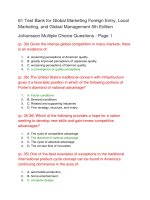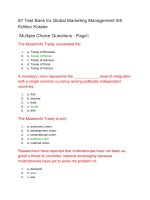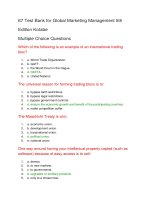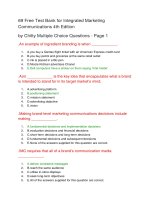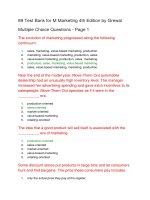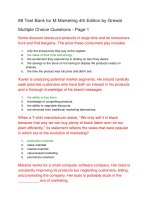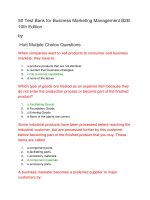81 test bank for global marketing foreign entry
Bạn đang xem bản rút gọn của tài liệu. Xem và tải ngay bản đầy đủ của tài liệu tại đây (124.95 KB, 21 trang )
Test Bank for Global Marketing Foreign Entry, Local Marketing,
and Global Management 5th Edition Johansson
Multiple Choice Questions - Page 1
(p. 34) The fundamental rationale for the existence of international
trade is based upon the principle of:
1.
2.
3.
4.
A. comparative advantage.
B. absolute advantage.
C. political advantage.
D. economic necessity.
(p. 35) The theory of comparative advantage is extended by
Porter's concept of:
1.
2.
3.
4.
A. the international product cycle.
B. the circular flow of innovation.
C. the diamond of national advantage.
D. economic Darwinism.
(p. 38) Which of the following is most consistent with the concept
of the learning organization?
1.
2.
3.
4.
A. International product cycle
B. Diamond of national advantage
C. New trade theory
D. Circular flow of innovation
(p. 38) The "country-of-origin" phenomenon seems to have a
particularly strong impact upon perceptions of:
1.
2.
3.
4.
A. quality.
B. style.
C. price.
D. content.
(p. 34-35) For which of the following advantages is location
fixed?
1.
2.
3.
4.
A. Low cost labor
B. Services
C. Knowledge workers
D. Raw materials
(p. 34) If a company's strength is not firm-specific, then its
competitive advantage is usually:
1.
2.
3.
4.
A. less imitable.
B. less vulnerable to competition.
C. less sustainable.
D. not subject to change.
(p. 35) According to the _____, an innovating country will
eventually import the products it created.
1.
2.
3.
4.
A. international product cycle
B. principle of absolute advantage
C. principle of comparative advantage
D. circular flow of innovation model
(p. 39) Given the intense global competition in many markets,
there is an evidence of:
1.
2.
3.
4.
A. worsening perceptions of American quality.
B. greatly improved perceptions of Japanese quality.
C. worsening perceptions of German quality.
D. a convergence of quality perceptions.
(p. 35-36) Which of the following provides a hope for a nation
seeking to develop new skills and gain/renew competitive
advantages?
1.
2.
3.
4.
A. The cycle of competitive advantage
B. The diamond of national advantage
C. The cycle of absolute advantage
D. The circular flow of innovation
(p. 33) The America-First Corporation is preparing to "go global"
by simultaneously entering several foreign markets. To be
successful, the firm must understand:
1.
2.
3.
4.
A. its competitive advantages in these markets.
B. global compensation.
C. import/export laws.
D. electronic communication.
(p. 35) The shift of focus of American industry from home
entertainment products such as television and VCRs to computer
design is explained by:
1.
2.
3.
4.
A. the diamond of national advantage model.
B. the circular flow of innovation model.
C. the cycle of absolute advantage model.
D. the international product cycle model.
(p. 35) A country's absolute advantage may eventually be erased
by foreign competitors through the operation of:
1.
2.
3.
4.
A. political pressure.
B. the international product cycle.
C. cartels.
D. free trade zones.
(p. 37) According to Porter, as the manufacturing costs increase
in a country's industry:
1.
2.
3.
4.
A. the country becomes less competitive.
B. the country can still remain competitive in that industry.
C. the country will begin focusing on other industries.
D. the country will shift its focus to trading in standardized commodities.
(p. 41) A resource-based strategy defines the firm in terms of:
1.
2.
3.
4.
A. the products it markets.
B. the services it markets.
C. the needs it seeks to satisfy.
D. what it is capable of doing.
(p. 34) A country which is more efficient/productive than all other
nations with regard to a specific product or resource is said to
have a(n):
1.
2.
3.
4.
A. comparative advantage.
B. monopoly.
C. absolute advantage.
D. trade deficit.
(p. 35) The United State's traditional concern with infrastructure
gives it a favorable position in which of the following portions of
Porter's diamond of national advantage?
1.
2.
3.
4.
A. Factor conditions
B. Demand conditions
C. Related and supporting industries
D. Firm strategy, structure, and rivalry.
(p. 31) Nike and Reebok were the main competitors for sneakers
in the international market in the 1980's, but lost some of their
share by which other sneaker brand in the 1990s?
1.
2.
3.
4.
A. Puma
B. Adidas
C. Pony
D. U.S. Keds
(p. 34) According to the 1981 Dunning study of comparative
advantage, what advantage did the U.S. have?
1.
2.
3.
4.
A. Technology of all kinds
B. Transportation equipment
C. Food products
D. Mechanical engineering
(p. 38) According to the _____, a country can become efficient in
the production of goods in which it starts with little or no
comparative advantage.
1.
2.
3.
4.
A. international product cycle
B. new trade theory
C. cycle of innovation
D. circular flow of innovation
(p. 35) One of the best examples of exceptions to the traditional
international product cycle concept can be found in America's
continuing dominance in the area of:
1.
2.
3.
4.
A. automobile production.
B. home entertainment.
C. computer design.
D. textiles.
(p. 33) The fundamental aim of business strategy is to create and
maintain:
1.
2.
3.
4.
A. lower prices.
B. efficient channels.
C. a competitive advantage.
D. production efficiency.
(p. 34) After the 1981 Dunning study of comparative advantage,
the advantage in _____ has moved from Japan to other Asian
countries.
1.
2.
3.
4.
A. technology
B. transportation equipment
C. food products
D. textiles
(p. 41) One of the major goals of a knowledge-based organization
would be to develop:
1.
2.
3.
4.
A. product advantages.
B. firm-specific advantages.
C. trade barriers.
D. transferred advantages.
(p. 40) A firm-specific advantage is synonymous with:
1.
2.
3.
4.
A. country-specific advantage.
B. comparative advantage.
C. location-specific advantage.
D. differential advantage.
(p. 40) The America-First Corporation has an unusually large
number of patents for critical technological innovations. This fact
gives the company an important:
1.
2.
3.
4.
A. location specific advantage.
B. comparative advantage.
C. firm-specific advantage.
D. advertising advantage.
(p. 37) The development of high-technology areas such as Silicon
Valley south of San Francisco can be best explained by:
1.
2.
3.
4.
A. international product cycle.
B. new trade theory.
C. cycle of innovation.
D. circular flow of innovation.
61 Free Test Bank for Global Marketing Foreign Entry,
Local Marketing, and Global Management 5th Edition
Johansson Multiple Choice Questions - Page 2
(p. 48) The America-First Corporation is attempting to identify the
members of the strategic group it would confront in the Russian
market. This group would consist of firms whose resources and
choice of target markets would:
1.
2.
3.
4.
A. mark them as potential allies.
B. make them follow similar strategies.
C. remove them from competitive concern.
D. assist the firm's entry.
(p. 48) Porter's "five forces" model emphasizes all of the following
considerations EXCEPT:
1.
2.
3.
4.
A. rivalry.
B. international law.
C. substitutes.
D. buyer power.
(p. 53) Which of the following activities are LEAST likely to feature
during the foreign entry phase?
1.
A. Decision on what to offer
2.
3.
4.
B. How a firm should enter aboard
C. Timing new product entries
D. Assessment of the market
(p. 51) The capability of a global firm to attack a competitor in
several markets, and to defend a market by countering elsewhere
is referred to as:
1.
2.
3.
4.
A. strategic intent.
B. competitive repertoire.
C. integrated competitive moves.
D. leveraged local presence.
(p. 48) The most obvious competitive force a firm considering
entry into a new market must consider is the:
1.
A. intensity of competitive rivalry between firms competing directly in that
market.
2. B. cost of distribution to that market.
3. C. political system in that market.
4. D. natural resources available in that market.
(p. 45) Banks and brokerage houses link buyers and sellers
across borders and provide information as part of their role as:
1.
2.
3.
4.
A. internalizers.
B. market makers.
C. transaction cost agents.
D. market movers.
(p. 53-54) A resource-based strategic perspective is
most_appropriate in the:
1.
2.
3.
4.
A. foreign entry phase.
B. local marketing phase.
C. global management phase.
D. both foreign entry and global management phases.
(p. 54) With _____, the focus shifts back to headquarters and the
resource perspective.
1.
2.
3.
4.
A. the foreign entry phase
B. global management
C. the local marketing phase
D. the location economy phase
(p. 53) During which phase of global marketing is assessment of
the market, customer segments, and competitive offerings often
done through informal methods and by independent middlemen?
1.
2.
3.
4.
A. Foreign entry phase
B. Local marketing phase
C. Foreign entry and local marketing phases
D. Global management phase
(p. 47) Changing the value chain by simplifying the entire flow
from raw materials to the ultimate consumer is called:
1.
2.
3.
4.
A. industrialization.
B. benchmarking.
C. externalization.
D. industrial rationalization.
(p. 44) The America-First Corporation often employs licensing as
a means of entering foreign markets. This approach would be
described as the:
1.
2.
3.
4.
A. internalization option.
B. legalistic option.
C. transference option.
D. externalization option.
(p. 49) Tariffs, regulations, and national security concerns have
traditionally been designed to favor:
1.
2.
3.
4.
A. foreign entries.
B. strategic groups.
C. competitive rivals.
D. domestic competitors.
(p. 44) The America-First Corporation has decided to safeguard
control of its firm-specific advantages as much as it can. The firm
will probably seek to enter foreign markets under a(n):
1.
2.
3.
4.
A. externalization option.
B. decentralized option.
C. internalization option.
D. negotiated option.
(p. 42) The America-First Corporation is considering how it can
best transfer its marketing skills to foreign markets. The firm
should probably focus on:
1.
2.
3.
4.
A. extensive use of expatriates.
B. transferring its best domestic talent to foreign markets.
C. hiring/training local people.
D. implement ethnocentric staffing policy.
(p. 44) The possibility that licensing fees will not be collected
and/or that foreign firms will utilize licensed technology for export
is called:
1.
2.
3.
4.
A. dissipation.
B. deception.
C. demarcation.
D. de-licensure.
(p. 45) Collectively, transportation charges, sales taxes, and
brokerage fees are called:
1.
2.
3.
4.
A. market makers.
B. tariffs.
C. transaction costs.
D. trade barriers.
(p. 42) Marketing skills are especially difficult to transfer abroad
because of their:
1.
2.
3.
4.
A. intangibility.
B. reliability upon technology.
C. product-dependence.
D. regulation under import legislation.
(p. 52) As a true, global company, the America-First Corporation
often starts price wars in selected markets to "occupy" rivals and
conceal its entry into new markets. This strategy is an example
of:
1.
2.
3.
4.
A. integrated competitive moves.
B. global advertising.
C. strategic intent.
D. leveraged local presence.
(p. 52) The America-First Corporation has experienced problems
in finding distributors and other intermediaries in Japan. The
Japanese have "institutionalized" Galbraith's concept of
countervailing power in the form of:
1.
2.
3.
4.
A. buying cartels.
B. supplier blocs.
C. keiretsus.
D. kabuki blocs.
(p. 54) The global marketing manager will do all of the following
EXCEPT which one in order to achieve synergistic efficiency.
1.
A. Borrow as much money as possible from foreign bankers so as to
spread risk
2. B. Synchronize strategic moves in various countries
3. C. Standardize products and services
4. D. Coordinate activities and timing of new product entries
(p. 50) Porter's concern with buyer and supplier power relate to
John Kenneth Galbraith's concept of:
1.
2.
3.
4.
A. monopoly.
B. countervailing power.
C. local control.
D. cartel dislocation.
(p. 49) The global financial turmoil at the end of the 90s led to:
1.
2.
3.
4.
A. deregulation, privatization, and global integration.
B. a backlash in some countries against free markets.
C. trading blocs which encouraged economic integration.
D. removal of entry barriers for foreign firms.
(p. 50) Due to differences in preferences, tastes, and habits, a
foreign firm may be forced to develop strategies designed to
compete with domestic producers of market-specific:
1.
2.
3.
4.
A. initiations.
B. substitutes.
C. reproductions.
D. counterfeits.
(p. 53-54) A resource-based strategic perspective is most
appropriate in the:
1.
2.
3.
4.
A. foreign entry phase.
B. local marketing phase.
C. global management phase.
D. both foreign entry and global management phases.
(p. 45) As it seeks foreign opportunities, the America-First
Corporation actively pursues forward and backward vertical
integration. The firm's approach is most consistent with the
principle of:
1.
2.
3.
4.
A. decentralization.
B. market-making.
C. externalization.
D. internalization.
(p. 49) As a firm globalizes, its most direct competitors tend to
be:
1.
2.
3.
4.
A. foreign entrants.
B. domestic competitors.
C. domestic cartels.
D. domestic government-owned firms.
(p. 43) Manufacturing companies need not investment in
technology transfer since:
1.
2.
3.
4.
A. these factors often represent intangibles.
B. the incentive to go abroad is not as strong.
C. the final product embodies the advantages already.
D. the results of these efforts can be uncertain.
(p. 45) A firm is most likely to opt for an FDI strategy when:
1.
2.
3.
4.
A. it has strong domestic country-specific advantages.
B. transportation costs to foreign markets are low.
C. strong foreign country-specific advantages exist.
D. good foreign middlemen are cheap and easily available.
(p. 53) Unforeseen shifts in customer preferences, potential
channel conflict, uncertainty about advertising effectiveness, and
competitors' price cuts are managerial headaches during:
1.
2.
3.
4.
A. the foreign entry phase.
B. the local marketing phase.
C. both foreign entry and local marketing phases.
D. the global management phase.
(p. 42) Technology transfer is usually easiest for:
1.
2.
3.
4.
A. firms with marketing FSAs.
B. manufacturers.
C. service franchisers.
D. the firms where the advantages are not embodied in the product.
(p. 53) The typical market-based approach to strategy is most
appropriate to which of the following phases of globalization?
1.
2.
3.
4.
A. The foreign entry phase
B. The global management phase
C. The local marketing phase
D. Both the local marketing and global management phase
(p. 49) All of the following tends to be true for foreign entrants in a
global market EXCEPT:
1.
A. foreign entrants tend to be the most direct competitors of a globalizing
firm.
2. B. foreign companies can often be analyzed as a separate strategic group.
3.
C. the similarity of their strategic situation that tends to suggest similar
strategies.
4. D. foreign companies from inside a trading area have a disadvantage over
other foreign competitors.
(p. 46) The switch to a resource-based strategy is most consistent
with:
1.
2.
3.
4.
A. the externalization concept.
B. the value chain concept.
C. the benchmarking concept.
D. the just-in-time concept.
(p. 48) Competitors with roughly similar resources and similar
target markets comprise a:
1.
2.
3.
4.
A. cartel.
B. competitive barrier.
C. strategic group.
D. strategic alliance.
(p. 52) Coca-Cola's experience of capturing market share from
Pepsi in Russia is an example of:
1.
2.
3.
4.
A. using financial resources as a competitive tool.
B. using global advertising as a competitive tool.
C. technology innovations overpowering global presence.
D. global price-wars.
Free Text Questions
(p. 35-36) According to Porter's _____, a nation's competitive
advantage may be based on factor conditions, demand
conditions, related and supporting industries, and/or firm
strategy, structure, and rivalry.
Answer Given
diamond of national advantage
(p. 44) In terms of relative ease and degree of commitment, the
three alternative modes of foreign entry available to the
firm would range from _____ at the low-end, through _____
to the most demanding mode, _____.
Answer Given
pure export; licensing; foreign direct investment
(p. 42) A major difficulty in transferring marketing skills abroad is
that these factors often represent _____, skills that reside
in people and are not _____ in the product itself.
Answer Given
intangibles; "embodied"
(p. 42-43) The America-First Corporation enjoys internationally
known brands and a reputation for impeccable service. The
firm has decided to expand its firm-specific advantages into
the international arena. What problems are likely to be
encountered? How can the firm meet these challenges?
Answer Given
Marketing based firm-specific advantages are often intangible in nature--and may
not be easily transferred. America-First's brands may attract foreign customers
who are seeking the quality of service it stands for. The firm must be certain that
these foreign customers will not be disappointed. Local nationals, however, may
not be as dedicated to the provision of such services as the firm's domestic
employees. America-First should provide careful cultural preparation for domestic
managers sent to foreign countries. Local nationals must be carefully selected and
trained to ensure consistency of quality. The firm may opt for a franchising strategy
to achieve this goal.
(p. 41) Briefly describe the concepts of knowledge-based and
resource-based capability. How do these concepts relate to
the traditional emphasis upon customer orientation?
Answer Given
According to the knowledge-based concept, a firm's true strength is founded upon
the know-how, skills, and experiences of the company and its employees. The
ability of the firm to survive and prosper depends upon its ability to learn--and
change. This dynamic knowledge base is the primary asset of the firm.
Accordingly, a resource-based strategy defines the firm in terms of what it can
offer--what it is capable of--instead of current products, services, markets, or the
needs it might like to address. Simply knowing the customer is not enough-traditional market orientation is only a start. The firm must first know what its
strengths are--then seek out those markets in which those strengths can be
profitably employed for the benefit of both the firm and the customer.
(p. 41) _____ defines the firm not in terms of the products or
services it markets, or in terms of the needs it seeks to
satisfy, but in terms of what it is capable of.
Answer Given
Resource-based strategy
(p. 37-38) Briefly explain the basic tenets of new trade theory.
Answer Given
New trade theory postulates that advanced technology centers are likely to arise
around strong research universities and innovative new firms, local labor tends to
develop skills required by those industries, and similar companies will be attracted
by these advantages. Krugman pointed out that such conditions favored the
appearance of a variety of firms capable of producing a variety of products. Over
time, experience gained from diversification would tend to lead to specialization as
each producer creates firm-specific advantages from learning by doing. The
deliberate attempt to elevate this process to the stages of a strategy for the
continual "rebirth" of the firm is at the height of the learning organizations ability to
stay competitive.
(p. 48) _____ identifies five sources of competitive pressures on
the firm in a given industry: rivalry, new entrants, _____,
buyer power, and supplier power.
Answer Given
Porter's "five forces" model; substitutes
(p. 37-38) According to _____ theorists such as Krugman, _____
leads to _____ and the creation of firm-specific advantages
that come from learning by doing.
Answer Given
new trade; differentiation; specialization
(p. 35) Describe the relationship between free trade and the
ability of nations to benefit from comparative advantage.
What role does technology transfer playing this process?
Answer Given
Free trade is a necessary condition for the exercise of any nation's comparative
advantage. In the absence of free trade, each nation is forced to be more selfsufficient and less capable of developing the specialization that creates
comparative advantages. Over time, large markets may attract local
manufacturing investments by foreign-owned MNCs. The technology transfers
which often accompany such investments provide a "second-best" solution by
creating a dynamic facet for a nation's CSAs. Eventually, shifting CSAs will tend to
favor the expansion of free trade.
(p. 44-45) The America-First Corporation is preparing to enter
international trade. How can the firm "match" its skills to
potential foreign markets? Briefly describe the primary
modes of entry available to the firm. Why would AmericaFirst be concerned with choosing between an
externalization or internalization strategy?
Answer Given
America-first should carefully assess its firm-specific advantages to determine
which markets it can best serve and evaluate country-specific advantages to
determine from which countries this should be done. The firm may choose from
pure exporting, licensing, or direct foreign investment as the primary vehicles
through which their expertise may be "internalized" in foreign markets. In pure
exporting, the product is simply transferred to a distributor appointed in the target
country. Licensing involves the use of contractual arrangements to transfer some
ownership advantages to an enterprise in a foreign country. Foreign direct
investment would require the firm to spend funds to create subsidiary firms in
other nations. The use of licensing in an "externalization" strategy could dissipate
the firm's advantages. America-First may retain more control under the
"internalization" options of exportation or direct foreign investment.
(p. 36-37) The America-First Corporation, a major innovator in the
computer industry from its inception, is still the dominant
firm in computer design and development worldwide. How
can the firm's continued dominance of this highly
competitive industry be explained given the concept of the
international product cycle?
Answer Given
The "best" explanation is probably offered by Porter's National "Diamond" Theory
which explains competitive advantage through the dynamic interaction of factor
conditions, demand conditions, related or supporting industries, and firm strategy,
structure, and rivalry. Typically, an innovator achieves dominance through
superiority in such factors as labor or infrastructure. Over time, vigorous
competition from rivals can strengthen the innovator and encourage growth and
improvement among supplier firms. Sophisticated and demanding domestic
customers will further sharpen competitive skills. Porter's theory holds that an
innovating firm can maintain dominance by emphasizing that factor in which it has
the greatest current advantage while continually seeking to improve in all areas.
By developing new skills and reviewing competitive advantages, a firm may
remain competitive even as its manufacturing costs rise. This runs counter to the
IPC in that a country can remain competitive if it renews itself and develops new
skills.
(p. 35) The _____ was initially proposed by _____ in 1966, who
used it to demonstrate how the manufacturing of new
products in the United States shifted over time to new
locations overseas and in the process affected trade
patterns.
Answer Given
International Product Cycle; Raymond Vernon
(p. 46) The value chain is the _____ sequence of operations
undertaken by the firm. "Deconstructing" the value chain is
equivalent to _____.
Answer Given
"internalized"; externalization
(p. 37) Explain the differences between Porter's diamond theory,
and the International Product Cycle theory. Which of these
are more applicable to the present day economies of the
world?
Answer Given
Porter's diamond is a dynamic theory, showing how over time a nation can build
up and sustain its competitive advantage in an industry. Vernon's IPC on the other
hand was used to demonstrate how the manufacturing of new products in the
United States shifted over time to new locations overseas and in the process
affected trade patterns. Porter's diamond implies that a country can remain
competitive in an industry even as its manufacturing costs rise. Thus, the diamond
goes counter to the original IPC theory. While the IPC explains the "hollowing out"
of a nation's industrial base, with manufacturing moving to low-wage countries,
Porter's diamond suggests that competitive rivalry and capable business
management can help nations develop new skills and renew their competitive
advantages. While Vernon's IPC concludes that advanced nations will trade for
standardized commodities and focus on innovation and new industries ("get out of
televisions, and focus on computers"), Porter's diamond shows how the creation of
favorable conditions can make a nation stay competitive in a given industry for a
long time ("automobiles is what we do best"). Actually, in most economies of the
world, both tendencies are at work simultaneously.
(p. 46-47) Briefly discuss the concept of "industrial
rationalization". How does this concept relate to other
concepts discussed in the text?
Answer Given
Following a strategy of industrial rationalization, a firm would seek to simplify the
entire flow, from raw materials to ultimate consumer. Such an effort would require
the firm to recognize the reality of hypercompetition and to engage in
benchmarking across the competitive spectrum. The resulting learning
organization would seek to develop FSAs that can strengthen resource-based
strategies that can expand, protect, and leverage its competitive strengths in all of
its markets. It will expand its competitive repertoire, initiative integrated
competitive moves, and enhance its ability to rely upon internalized strength to
avoid the problems associated with the international product cycle.
(p. 33-34) The traditional justification for a country's exports is the
principle of _____ advantage-which may be derived from
either _____ or _____ advantages.
Answer Given
competitive; country-specific; firm-specific
(p. 44-46) Why is transaction framework relevant to the
international marketer? How does this theory relate to
FSAs, integration, and the choice between an
internalization or externalization strategy?
Answer Given
Transaction costs, the costs incurred in completing a transaction between a buyer
and seller, are at the heart of marketing activities. If these "market-making" costs
are too high, trade is prohibited. In an effort to lower transaction costs to an
acceptable level, firms employ specialists in those areas in which they lack
experience or expertise. Over time, some firms develop firm-specific advantages
in market-making activities which allow the company to practice forward or
backward integration. Vertical integration is a form of internalization strategy which
allows the firm to maximize both savings and control. An externalization strategy,
as expressed in the use of agents, brokers, or other external specialists, allows
cost savings--at the expense of control. An internalized strategy surfaces as pure
exporting or direct foreign investment in international trade. Licensing is a form of
externalization that may be taken into foreign markets.
(p. 44) Firms which opt for either the pure export mode or foreign
direct investment are practicing the strategy of _____.
Answer Given
internalization
(p. 33-34) Briefly describe the concept of country-specific
advantage and differentiate between absolute and relative
advantages. Why should the marketer be concerned with
firm specific advantages and barriers to entry?
Answer Given
Country-specific advantages traditionally referred to natural resource and labor
factors that allowed a particular nation to produce specific goods more efficiently
than could rival nations. The concept has been broadened to include advantages
in market knowledge/proximity, legal/commercial expertise, and transportation
specialization. A country would enjoy an absolute advantage only if it can produce
all products more efficiently than other nations. It is more likely that a nation will be
able to produced one, or a few product(s)--that is, exhibit a relative advantage with
respect to other nations. Firm-specific advantages help the marketer in identifying
those products in which his/her firm can be most competitive/profitable. The
existence of tariffs or other trade barriers may cause the marketer to eliminate the
option of exporting in favor of licensing know-how (externalization) or investing in
local production (internalization).
